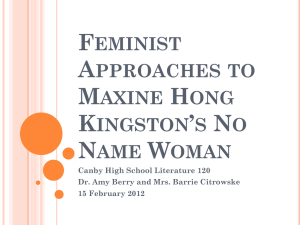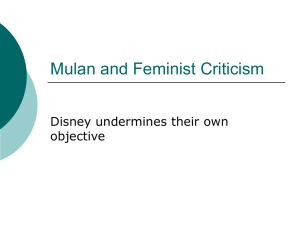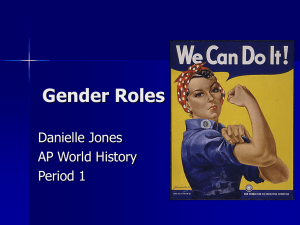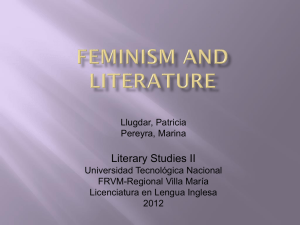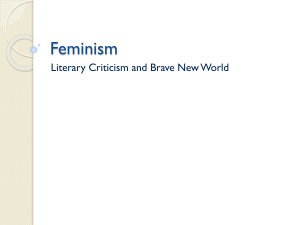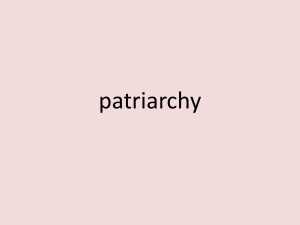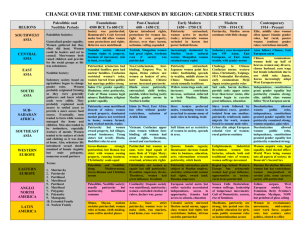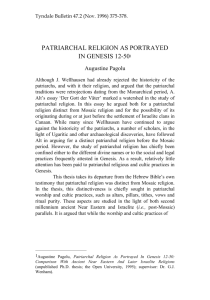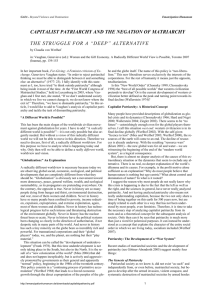AP Eng Lit Feminist Literary Theory
advertisement
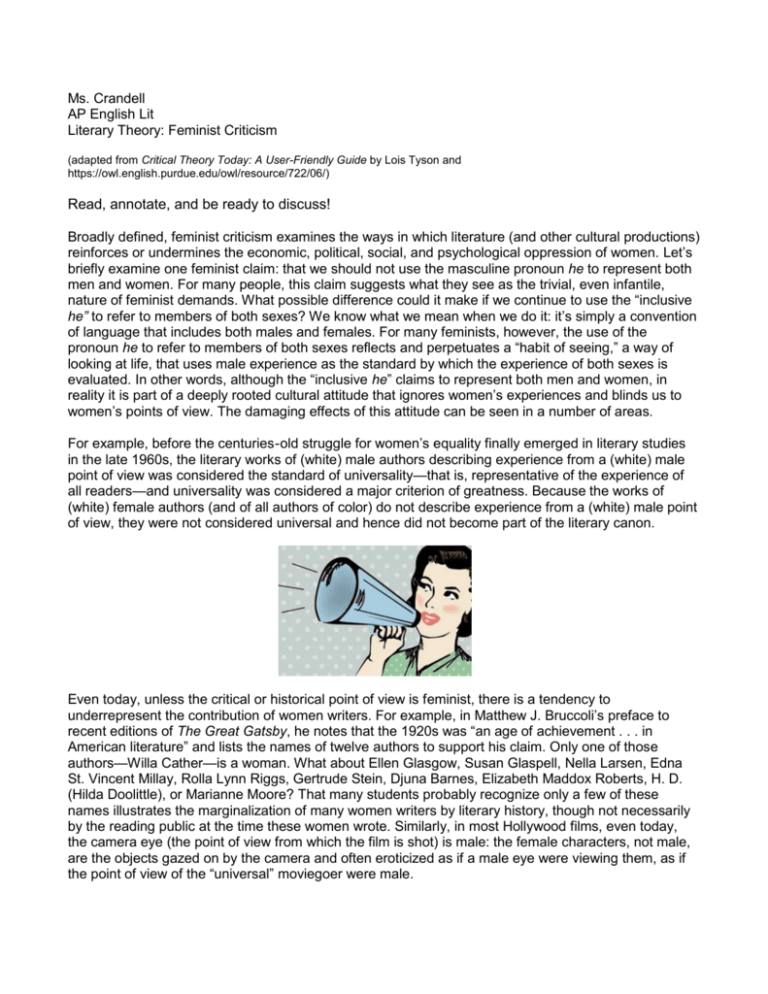
Ms. Crandell AP English Lit Literary Theory: Feminist Criticism (adapted from Critical Theory Today: A User-Friendly Guide by Lois Tyson and https://owl.english.purdue.edu/owl/resource/722/06/) Read, annotate, and be ready to discuss! Broadly defined, feminist criticism examines the ways in which literature (and other cultural productions) reinforces or undermines the economic, political, social, and psychological oppression of women. Let’s briefly examine one feminist claim: that we should not use the masculine pronoun he to represent both men and women. For many people, this claim suggests what they see as the trivial, even infantile, nature of feminist demands. What possible difference could it make if we continue to use the “inclusive he” to refer to members of both sexes? We know what we mean when we do it: it’s simply a convention of language that includes both males and females. For many feminists, however, the use of the pronoun he to refer to members of both sexes reflects and perpetuates a “habit of seeing,” a way of looking at life, that uses male experience as the standard by which the experience of both sexes is evaluated. In other words, although the “inclusive he” claims to represent both men and women, in reality it is part of a deeply rooted cultural attitude that ignores women’s experiences and blinds us to women’s points of view. The damaging effects of this attitude can be seen in a number of areas. For example, before the centuries‐old struggle for women’s equality finally emerged in literary studies in the late 1960s, the literary works of (white) male authors describing experience from a (white) male point of view was considered the standard of universality—that is, representative of the experience of all readers—and universality was considered a major criterion of greatness. Because the works of (white) female authors (and of all authors of color) do not describe experience from a (white) male point of view, they were not considered universal and hence did not become part of the literary canon. Even today, unless the critical or historical point of view is feminist, there is a tendency to underrepresent the contribution of women writers. For example, in Matthew J. Bruccoli’s preface to recent editions of The Great Gatsby, he notes that the 1920s was “an age of achievement . . . in American literature” and lists the names of twelve authors to support his claim. Only one of those authors—Willa Cather—is a woman. What about Ellen Glasgow, Susan Glaspell, Nella Larsen, Edna St. Vincent Millay, Rolla Lynn Riggs, Gertrude Stein, Djuna Barnes, Elizabeth Maddox Roberts, H. D. (Hilda Doolittle), or Marianne Moore? That many students probably recognize only a few of these names illustrates the marginalization of many women writers by literary history, though not necessarily by the reading public at the time these women wrote. Similarly, in most Hollywood films, even today, the camera eye (the point of view from which the film is shot) is male: the female characters, not male, are the objects gazed on by the camera and often eroticized as if a male eye were viewing them, as if the point of view of the “universal” moviegoer were male. Perhaps the most chilling example of the damaging effects of this “habit of seeing” is found in the world of modern medicine, where drugs prescribed for both sexes often have been tested on male subjects only. In other words, in laboratory tests to determine the safety of prescription drugs before marketing them, men’s responses frequently have been used to gather statistical data on the medications’ effectiveness and possible side effects. As a result, women may experience unexpected side effects while male users are unaffected. How could medical scientists not have anticipated this problem? Surely, the cultural habit of seeing male experience as universal played a role. Traditional Gender Roles Traditional gender roles cast men as rational, physically strong, protective, and decisive; they cast women as emotional (irrational), physically weak, nurturing, and submissive. These gender roles have been used very successfully to justify inequities, which still occur today, such as excluding women from equal access to leadership and decision‐making positions (in the family as well as in politics, academia, and the corporate world), paying men higher wages than women for doing the same job (if women are even able to obtain the job), and convincing women that they are not fit for careers in such areas as mathematics and engineering. Many people today believe such inequities are a thing of the past because anti-discriminatory laws have been passed, such as the law that guarantees women equal pay for equal work. However, these laws are frequently side‐stepped. For example, an employer can pay a woman less for performing the same work as a man (or for doing more work than a man) simply by giving her a different job title. So women still are paid roughly between fifty‐five and eighty cents, depending on their ethnicity and age, for every dollar earned by men. Feminists don’t deny that there are biological differences between men and women; in fact, many feminists celebrate those differences. But they don’t agree that such differences as physical size, shape, and body chemistry make men naturally superior to women: for example, more intelligent, more logical, more courageous, or better leaders. Feminism therefore distinguishes between the word sex, which refers to our biological constitution as female or male, and the word gender, which refers to our cultural programming and/or identification as feminine, masculine, both, or neither. In other words, women are not born feminine, and men are not born masculine. Rather, these gender categories are constructed by society, which is why this view of gender is an example of what has come to be called social constructionism. The belief that men are superior to women has been used, feminists have observed, to justify and maintain the male monopoly of positions of economic, political, and social power, in other words, to keep women powerless by denying them the educational and occupational means of acquiring economic, political, and social power. That is, the inferior position long occupied by women in patriarchal society has been culturally, not biologically, produced. The norms and values of patriarchal society can be defined, in short, as any aspect of culture that privileges men by promoting traditional gender roles. Feminism and Fairly Tales To briefly illustrate the debilitating effects of patriarchal gender roles on both women and men, consider the story of “Cinderella.” Feminists have long been aware that the role of Cinderella, which patriarchy imposes on the imagination of young girls, is a destructive role because it equates femininity with submission, encouraging women to tolerate familial abuse, wait patiently to be rescued by a man, and view marriage as the only desirable reward for “right” conduct. By the same token, however, the role of Prince Charming—which requires men to be wealthy rescuers responsible for making their women happy “ever after”—is a destructive role for men because it promotes the belief that men must be unflagging superproviders without emotional needs. Consider the similarities among “Cinderella,” “Snow White and the Seven Dwarfs,” and “Sleeping Beauty.” In all three tales, the main female characters are stereotyped as either “good girls” (gentle, submissive, virginal, angelic) or “bad girls” (violent, aggressive, worldly, monstrous). These characterizations imply that if a woman does not accept her patriarchal gender role, then the only role left her is that of a monster. In all three tales, the “bad girls”—the wicked queen in “Snow White,” the wicked fairy in “Sleeping Beauty,” and the wicked stepmother and stepsisters in “Cinderella”—are also vain, petty, and jealous, infuriated because they are not as beautiful as the main character or, in the case of the wicked fairy, because she wasn’t invited to a royal celebration. Such motivations imply that even when women are evil, their concerns are trivial. In two of the stories, the young maiden is awakened from a deathlike slumber by the potent (after all, it brings her to life) kiss of the would‐be lover. This ending implies that the proper patriarchal young woman is sexually dormant until “awakened” by the man who claims her. The Madonna-Whore Complex Patriarchal ideology suggests that there are only two identities a woman can have. If she accepts her traditional gender role and obeys the patriarchal rules, she’s a “good girl”; if she doesn’t, she’s a “bad girl.” These two roles—also referred to as “madonna” and “whore” or “angel” and “bitch”—view women only in terms of how they relate to the patriarchal order. Of course, how “good girls” and “bad girls” are specifically defined will alter somewhat according to the time and place in which they live. But it is patriarchy that will do the defining because both roles are projections of patriarchal male desire: for example, the desire to own “valuable” women suited to be wives and mothers, the desire to control women’s sexuality so that men’s sexuality cannot be threatened in any way, and the desire to dominate in all financial matters. This last desire is well served by the patriarchal ideology that deems certain kinds of work improper for “good girls,” an ideology that forced many women writers in Victorian England to publish their work under male pseudonyms and that required women writers on both sides of the Atlantic to accommodate their art to patriarchal expectations or face the consequences (as Kate Chopin did at the turn of the twentieth century when her work was buried due to its feminist content, not to be reprinted until it was rediscovered by feminists in the late 1960s). Mary Wollstonecraft resisted patriarchal ideology in 1792 when she wrote A Vindication of the Rights of Woman; French writer Simone de Beauvoir took this even further in her groundbreaking The Second Sex (1949), in which she created a theoretical basis for feminists for decades to come. In a patriarchal society, Beauvoir observes, men are considered essential subjects (independent selves with free will), while women are considered contingent beings (dependent beings controlled by circumstances). Men can act upon the world, change it, give it meaning, while women have meaning only in relation to men. Thus, women are defined not just in terms of their difference from men, but in terms of their inadequacy in comparison to men. The word woman, therefore, has the same implications as the word other. A woman is not a person in her own right. She is man’s Other: she is less than a man; she is a kind of alien in a man’s world; she is not a fully developed human being the way a man is. Arguing that women are not born feminine but rather conditioned to be feminine by patriarchy, Beauvoir articulated the idea of social constructionism in her now‐famous words, “One is not born a woman; one becomes one” (cited in Moi 92). Indeed, Beauvoir argues that, despite patriarchy’s assumptions to the contrary, women are not even born with a maternal instinct. An instinct is something all members of a species have as part of their natural biological makeup, whereas not all women want to have children or feel comfortable being mothers. Yet patriarchy tells them that they are unfulfilled as women if they don’t have children, and there is a great deal of pressure brought to bear upon women in order to recruit them for motherhood. Clearly, how can we know what “woman” is “by nature,” given that we never see her outside the social conditioning of patriarchy? Furthermore, Hélène Cixous argues that language reveals what she calls patriarchal binary thought, which might be defined as seeing the world in terms of polar opposites, one of which is considered superior to the other. Examples include such hierarchical binary oppositions as head/heart, father/mother, culture/nature, intelligible/palpable (that which can be understood by the mind versus that which can be felt by the body), sun/moon, and activity/passivity. Oppositions like these organize the way we think, and for each opposition Cixous asks, “Where is [the woman]?” (91). That is, which side of each opposition is assumed to define some aspect of the female? Clearly, according to patriarchal thinking, the woman occupies the right side of each of these oppositions, the side that patriarchy considers inferior—heart, mother, nature, palpable, moon, and passivity—while it is assumed that the male is defined by the left side of each opposition, the side that patriarchy considers superior: head, father, culture, intelligible, sun, and activity. “Traditionally,” Cixous notes, “the question of sexual difference is treated by coupling it with the opposition activity/passivity” (92). In other words, patriarchal thinking believes that women are born to be passive while men are born to be active because it is natural for the sexes to be different in this way. Thus, if a woman is not passive, she is not really a woman. Of course, it follows that women are naturally submissive to men, that men are natural leaders, and so forth. Patriarchal power is also evident, for Luce Irigaray, in what many thinkers refer to as the male gaze: the man looks; the woman is looked at. And it is the one who looks who is in control, who holds the power to name things, the power to explain the world and so to rule the world. The one looked at—the woman—is merely an object to be seen. Thus, in a patriarchy, women are merely tokens, markers, commodities in a male economy. In other words, women function to display men’s relations to other men. To cite the simplest example, a patriarchal man who feels he must have a beautiful woman on his arm in order to impress other people isn’t interested in impressing other people. He’s interested in impressing other men. In short, patriarchy is a man’s world: men invent the rules of the game, they play it only with one another, and women are merely to be found among the prizes. Feminism and gender studies are intimately related. They share some of the same subject matter as well as a desire for justice and a belief in the power of education to change our society for the better. In this pursuit, some feminist critics have emphasized the similarities among all human beings. Another useful illustration of the similarities between women and men—this time in terms of the power dynamics that can be found in some cultures—is offered by Maria Alexandra Lepowsky’s example of the people of Vanatinai, a small island near New Guinea, where “[i]deologies of male superiority or right of authority over women are notably absent, and ideologies of gender equivalence are clearly articulated” (150). Men and women in this culture have equal rights over their own labor and the products of their labor, equal access to the accumulation of material wealth, and equal access to the acquisition of prestige in the community. “Women are not characterized as weak or inferior. Women and men are valorized for the same qualities of strength, wisdom, and generosity” (Lepowsky 158). As the Vanatinai islanders illustrate, we can’t claim that male dominance is natural or universal—although many Americans do claim just that—and therefore we can’t claim that dominant behavior in human beings is biologically linked to sex. Feminism and Literature Naturally, some literary works will lend themselves more readily than others to feminist analysis or at least to certain kinds of feminist analyses. For students new to the field, it may be most useful to examine the ways in which literary texts reinforce patriarchy because the ability to see when and how patriarchal ideology operates is crucial to our ability to resist it in our own lives. This approach, applied to literary works in the male canon, was the dominant mode of feminist literary analysis in America during the 1970s, and it usually requires reading “against the grain” of the text’s apparent intention, for patriarchal literature is usually unconscious of the sexist ideology it promotes, or perhaps more precisely, patriarchal literature sees nothing wrong with its own sexism. Some Questions Feminist Critics Ask About Literary Texts: 1. What does the work reveal about patriarchy and how it operates (economically, politically, socially, or psychologically)? 2. How are women portrayed? How do these portrayals relate to the gender issues of the period in which the novel was written or is set? In other words, does the work reinforce or undermine patriarchal ideology? (In the first case, we might say that the text has a patriarchal agenda. In the second case, we might say that the text has a feminist agenda. Texts that seem to both reinforce and under‐ mine patriarchal ideology might be said to be ideologically conflicted.) 3. What does the work suggest about the ways in which race, class, and/or other cultural factors intersect with gender in producing women’s experience? 4. What does the work imply about the possibilities of sisterhood as a mode of resisting patriarchy and/or about the ways in which women’s situations in the world—economic, political, social, or psychological—might be improved?

